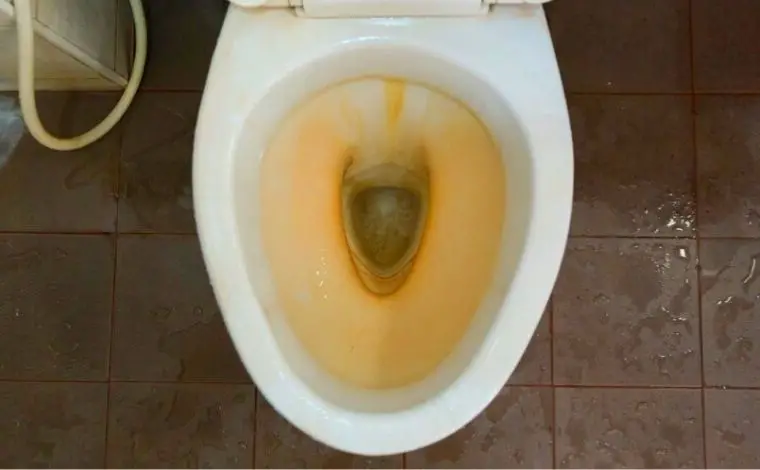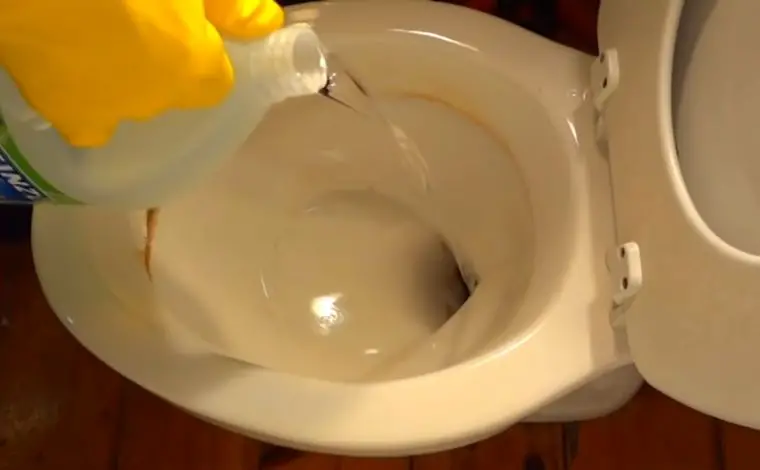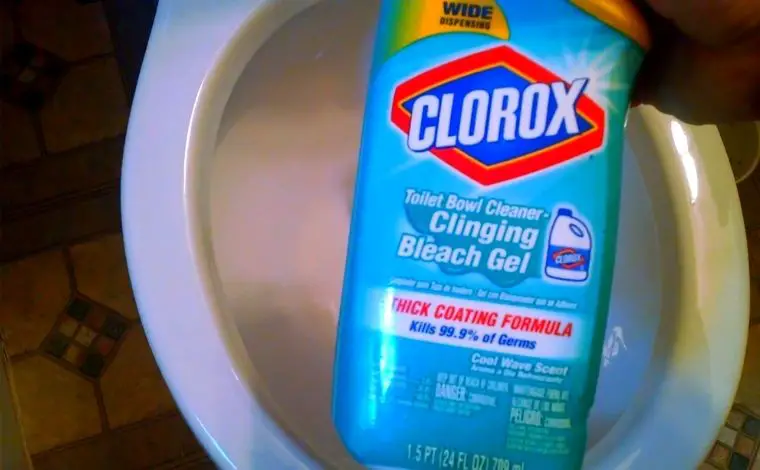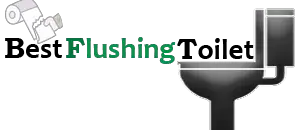Nowadays, none can think of spending a single day without using a toilet. But is the maintenance of the toilet that easy? What do you think? I bet all of you have faced the acute problem of having stubborn toilet bowl rings. Some of them may be red, green, yellow, black, or orange. But the most common of them is the yellow toilet bowl ring. Isn’t eradicating these messy toilet bowl rings seem a hassle? Most homeowners feel the agony while cleaning these stains and skid marks. What causes toilet bowl rings, and what are the prevention methods? In this article, I will elaborately discuss the causes, types, and elimination strategies of toilet rings, so let’s get started.
What Is a Toilet Bowl Ring?
The toilet bowl rings are the most acute and stubborn problems you may ever have faced. A toilet bowl ring is the brown, black, green, or discoloration and stains around the bowl’s waterline, which is created by mineral deposits, mildews, and bacteria. The toilet bowl rings are created mostly by the iron and minerals present in the water. Or there would be some other elements like manganese or calcium present In the water compounds. But the most common types of rings are caused by pooping and heavy-duty use of the toilet. For this reason, it is important to clean the toilet bowl every week.
It is actually an unpleasant buildup of bathroom residue that looks completely dissatisfying. The magic eraser is also quite effective in eradicating toilet bowl rings. It needs a proper scrubbing of the ring away with it immediately after soaking it in water. Apply this magic eraser into the bowl overnight and flush it away the next day to get a better result. A water softener might be effective also for eliminating the skid marks and coloring rings. It actually removes the hard elements from water and makes it less harmful to the surface of the toilet bowl. Always avoid using harsh chemicals as they corrode the surface of the toilet and leave scratches on the toilet surface.
Different types of toilet bowl rings and their causes
You may have encountered hundreds of types of Toilet Bowl Rings. But each of them is not that much harmful compared to the other dangerous types. Here I am enlisting some significant types of toilet bowl rings and skid marks.
| Toilet Ring Color | Possible Reason |
| What causes a black ring in the toilet bowl? | Calcium and magnesium |
| Pink color bowl rings: | Harmful Bacteria |
| Red color bowl toilet rings: | Acute Iron elements |
| Green color bowl rings: | Mold and fungus |
| Orange color bowl rings: | Magnesium and iron particles |
| Dark brown color bowl rings: | Acute hard water |
| Yellow color toilet bowl rings: | Tannins and poop marks |
What causes a yellow ring in the toilet bowl?
It is probably the most unhygienic and acute type of skid mark or ring caused by one of the dissolved, decayed organic matter called tannins. This creates a faint tint to a darker golden yellow like ginger or light tea up to a dark tea color. Tannins are hard to filter, but knowing they do not pose a health issue is significant. Tannins can cause more important issues in hard water, but having so many tannins in municipal water is simply aesthetically displeasing. 
The reason behind the red and brown rings on the bowl surface
A lot of iron in the water can cause acute Red or rust stains, which can be a pain to eradicate. A brown color indicates the presence of an extreme level of manganese. It is advised to install an iron and manganese removal system. The other factors may be old delivery systems and a fragile metal piping issue. A helpful solution may be a tiny pre-sediment filter at the home’s main water supply at the entrance point. If rust or discoloration is being produced from any of these within the home, you have a symptom of the enormous issue. A calculative strategy is needed to be undertaken to replace corroding pipes and resolve this acute problem.
Acute growth of green rings
The electrolysis can produce green or blue-greenish stains and discoloration. Two methods cause electrolysis: At first, where dissimilar metals are in contact, note the top of the water heater where the gray pipe is attached to the brass or sturdy copper pipes and the barnacles connected to the exterior of the connection, secondly, where the metal piping is not ground, which causes stains. This is a traditional issue with domestic chores that have been remodeled and homes with a complex mixture of pipe materials.
Green stains or discoloration that occur in the form of mold or mildew may have caused severe damage to the toilet. Water conditions upper or lower than the neutral pH range can form any copper or brass pipes or fittings to be shattered and create green or blue-greenish discoloration, and when it infiltrates down a surface, it can produce a stain. The appearance of Chloramine as the treatment method by the municipal water supply. Chloramine is the accumulation of chlorine and ammonia in order to disinfect the water. More decay on metal surfaces than chlorine, the result is not only observable as a stain or discoloration, but it will also create long-term issues like corrosion of pipes, leaks in pipes and connections, and damage to the home appliances.
Possible causes: Why does my toilet ring keep coming back?
There are thousands of different causes behind the occurrence of the Toilet Bowl Ring. Here I will depict all those causes with the necessary illustrations,
Mineral substances in hard water
Hard water is not suitable for clothes as well, as it is also harmful to all the toiletries. Hard water can create unnecessary dark brown rings in the bowl. The most useful way to eradicate these elements from the hard water is to apply the water softening agents and chemicals. These chemicals dissolve in water and eliminate the extra amount of magnesium and calcium. It takes a long time to create dark brown or black marks, but it becomes difficult to eradicate the ring after it is formed. 
Fungus and bacteria
The most common cause of creating a color mark on the toilet is the production of unwanted fungi and bacteria. Usually, these grow in damp areas with an ideal ambiance for reproducing mold, mildew, and bacteria. They are often seen at the edge of the toilet. The dark gray rings are the most other types of fungus and bacteria. The bacteria often leaves spot marks colored in deep pink, and you must use disinfectant toilet cleaners to eradicate these colorful rings.
Cleaning chemicals may discolor the toilet bowl
Many cleaning chemicals are applied to disinfect and clean the toilet, and it can possibly cause a permanent toilet bowl ring stain on the waterline. Sometimes the ring has been created around the bowl and problems with finishes or premature removal of sealants.
Most toilet bowl cleaners are made of dangerous chemicals that emit detrimental fumes while applied in the bowl. When constantly used over time, some of these chemicals will discolor the glossy finish of the toilet bowl, and it may yield a dull ring that is comparatively another different color than that of the bowl. You need to use a perfect toilet bowl cleaner; some may actually be specific to your needs. In some cases, the liquid chemical spills out of the bowl from the rim. After applying the liquid chemical, use a soft brush, put soft pressure against the bowl surface, and flush the toilet a few times. You must repeat this process before the reappearance of any discoloration.
Natural surfaces like granite and marble or tile and grout can be porous and need a proper sealant, and applying harsh and aggressive or incorrect cleaning will damage the sealant over time. If the sealant is mild and does not create harm to marble, travertine, granite, tile, and grout, then the bowl’s surface may last for a long time. The usage of these cleaning chemicals is dependent on the material or surface, and the sealing depends on the manufacturer’s recommendations that are compatible with the local conditions.
How to get rid of toilet mineral deposits?
The mineral deposits are the main elements that are responsible for the initiation of the skid marks. The Simple Process of getting a good toilet bowl is to use a disinfectant cleaner, product-specific cleaners for mineral or hard water deposits, and use the cleaners to squirt around the cleaner to the bowl rims.
You can use a sturdy brush to clean the toilet. Then water around the bowl and flush. Make a decent scrubbing, and then flush the toilet. Apply this process before the reappearance of the ring and stay safe from the reappearance of skid marks. Routine maintenance is the key to eradicating bad rings. Many toilet bowl cleaners are available in spray-on or leave-in formats that can effectively clean mineral deposits from the toilet bowl. These cleaners decently dissolve the ring and are rinsed away the next time the toilet is flushed. Some types of bathroom appliances like Bathtub sinks, drains, showerheads, and other surfaces also gather bad rings.
One method for impeding their growth is to keep these appliances dry and fresh as damp weather recreates the formation of fungi and bacteria. You can follow similar cleaning procedures as you would clean the toilet. The filtration and conditioning need to be softer on appliances, faucets, and fixtures. Use soft cleaners to avoid the deterioration of the tank fittings, flappers, gaskets, and other parts. By following these simple guidelines, you can undoubtedly get rid of the mineral deposits.
How to keep a toilet from getting a ring?
There are hundreds of proven strategies for removing the toilet bowl ring from the toilet. Here I will elaborate on some of the important secrets of removing the bowl ring:
Strategy-1: Applying the mixture of baking soda and vinegar
The first step is to add some baking soda, almost 1 tablespoon of baking soda, with 2 tablespoons of white vinegar. Pull down the toilet lid and let the ingredient soak for at least 10 to 15 minutes. Then dip the toilet brush and rinse gently for a few minutes. Apply the mixture in those areas which develop acute molds. Then flush the toilet 2 to 3 times and sweep away all the skid marks and toilet rings.
Strategy-2: Applying borax with vinegar
Borax is stronger than baking soda. That’s why it has been used as a cleaning agent; at the very first step, put some borax in the tank and bowl of the toilet. Let it soak for a few minutes. After that, apply 2 cups of white vinegar to the toilet. Keep in mind that it will produce a toxic fume after applying the vinegar, so use a face mask during the operation. Remove the stains and rings with a scrubber. Then flush the toilet. This will help remove the acute skid marks from the toilet.
Strategy-3: Applying bleach
Many think that bleach is the most harmful substance and cannot be applied to the toilet. That is not fully true, as it is the most suitable element for removing bacteria and molds from the toilet and removing discoloration in toilets. So take pure bleach, not the cleaners that contain bleach. Then mix in 1-2 tablespoons of bleach in a gallon of water and stir it well. Pour this mixture into the toilet and set it for a few hours. After a few hours, scrub the toilet bowl with a brush, remove the skid marks, and flush the toilet several times. That may clear the toilet once and for all.
Wrapping up
Cleaning a toilet bowl mark is not that simple; this is related to some hard cleanings. The cleaning process requires different harmful chemicals, so make sure that it doesn’t make any scratch on the bowl’s surface. You must have been baffled to have those acute toilet rings, but defeating those marks is not that difficult. So be wise while removing these skid marks; follow exactly how the guide tells you.
The most effective way must be the mixture of vinegar and borax; it is a proven way to solve this acute problem. I bet you won’t be disappointed to follow the above guidelines. These are not only effective for cleaning the skid marks, but they are also some health-friendly strategies for cleaning the toilet ring. If you benefited from this article, please share the knowledge with others so that they can acquire the benefit from these guidelines.
Related tips: How to remove limescale from the toilet?
Hi, this is Robert Crossan, the owner of this website, has 17 years of experience in the installation, maintenance, and repair of toilets and plumbing systems. After completing the Level 2 Basic Plumbing course in 2005, I started working in both domestic and commercial buildings as a professional plumber. So I can figure out the core difference between different toilet models and brands. It also helped me monitor their work performance and setbacks.








